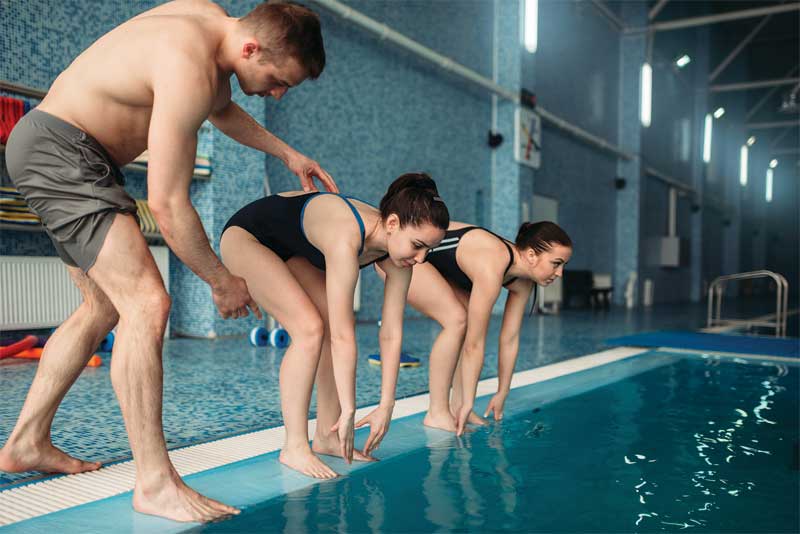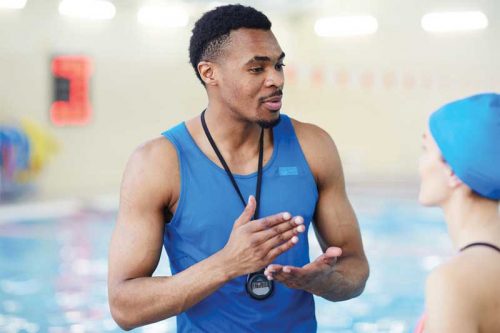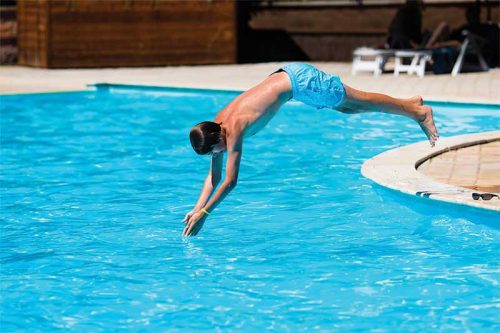Safer pool entry methods
by habiba_abudu | December 17, 2019 11:23 am
 [1]
[1]Every year an increasing number of pool-related accidents are reported, and injuries at public pools in Beamsville and Cambridge, Ont., due to improper diving techniques, point to a growing need for safer pool entry methods.
Considering a safe pool entry is important when learning how to swim. Entering the pool can either be daunting or very exciting for non-swimmers. Either way, it must be done in a safe and appropriate way. Facility owners and pool managers must ensure their staff, including lifeguards and instructors, teach non-swimmers how to enter pools safely—before they enter the water—to prevent any injuries.
Diving deep into basics
Diving techniques are especially important when it comes to entering pools safely. One such method is a ‘Penguin’ dive, which involves a headfirst entry into the water with the arms held tight on each side—similar to a penguin’s technique—as opposed to raising the arms overhead with the thumbs/hands locked and ears firmly pinned by the arms, which allows for body position corrections midflight and in the water. This method can result in loss of body control, causing the diver to strike their unprotected head and face against the concrete pool floor, which may result in spinal injury.
As numerous people partake in many water-related activities at public pools, not only is there a need to ensure everyone participates safely, but also for management to provide/maintain safe environments. Pool managers must ensure users are aware of safe pool entry methods prior to participating in any activity, whether it is cooling off, taking the first learn-to-swim (LTS) lesson, saving a life, performing a twist dive, or an aquatic fitness class.
Some of the most critical injuries and fatal falls from head impact can be attributed to lack of proper training or instructions for safe entry into the water.
Never swim alone; do not dive into unknown pools; always face a ladder when going up or down; do not run in the shower area or on the deck; no pushing or shoving near the water; no horseplay; no open cuts or sores; shower before swimming; no chewing gum; no adhesive bandages, etc.—these rules are well-known and usually discussed with participants before they enter the facility. However, many lessons may often slip through the cracks, resulting in serious neck, head, or spine injuries.
Education and training is key
 [2]
[2]Aquatic facility operators and managers need to keep abreast of the many pool entry techniques and ensure their staff is properly educated to identify and reduce the potential for dangers in and around the water. Understanding the nature of how quickly accidents can happen and the severity of not following established safety protocols is something all new and existing employees must be taught.
In the pool and spa/hot tub industry, many new, untrained workers can be added to the roster in a short period of time due to the seasonal fluctuations of the job. This can create a logistical problem with respect to bringing everybody up to speed when each worker is starting from a different level of base knowledge. Further, many instructors and lifeguards today are not competent in jumping or diving themselves. In the past, trainers have tended to avoid properly instructing swimmers on the astride jump entry, running dive with one foot takeoff, shallow racing dive followed by a head up crawl, the flip, or tumble turn progressions. That said, non-swimmers cannot be taught to jump and dive before actually learning to swim. Therefore, pool operators must make sure the instructors on-site are trained properly to educate pool users about the dos and don’ts of safe pool entry techniques.
When the University of Toronto hosted a seminar for divers led by the American diving coach Bruce Dick Kimball, the emphasis was on the basic theories of human movement in outer space, particularly for teaching/learning the inward and twisting group of dives—the two most difficult in-the-air actions for divers to initiate and recover from (or so it seemed at the time). Once the kinesiology or biomechanic principals of zero gravity twisting/turning mid-air, such as how figure skaters speed up their jumps, spins, and rotations using body mass relocation of their arms and head, are understood and learned, it becomes more of a management of learning skills than a formal teaching assignment to instruct a non-swimmer to enter the water safely and sensibly.
Diving techniques to enter the pool safely
There are various steps or modules that can be set out in all LTS courses to ensure once a participant learns the techniques of movement through the water, they have concurrently acquired the necessary skills to enter the pool or other water environments safely.1 An understanding or appreciation of the concept of weightlessness in a spacecraft can further help the learning process; therefore, postnatal or preschool non-swimmers might not be the best groups to adapt to the following skill sets. Aquatic facility owners should ensure their staff follows these lessons when coaching bathers to enter the water efficiently.
Skill lesson 1
 [3]
[3]In neck-deep water, bathers must enter the pool by facing the ladder, steps, or ramp and grasp/slide their hands down both the handrails until their feet touch the bottom of the pool. They should then walk to the nearest rim or gutter unassisted.
Skill lesson 2
One should be able to sit on the edge of the pool with an assistant (instructor) and/or classmate standing in neck-deep water. They must then slide into the water with assistant ‘spotting’ or grabbing hands to a steady standalone area in the water.
Skill lesson 3
Bathers should face the pool and crouch low with their toes curled over the edge and then jump into neck-deep water to a standing position without a spotter or any assistance.
Skill lesson 4
One must stand erect and jump into neck-deep water without any assistance, toes over the edge, and feet apart or together.
Skill lesson 4b
Bathers should repeat lesson 4, but try and jump out as far as possible using arm swing. Instructors can even organize a game or competition for a group at this point.
Skill lesson 4c
Bathers must repeat the previous lesson, but try and jump as high and as far out as possible.
Skill lesson 5
One must stand erect with both feet together, toes over the edge, and repeat 4c, but prior to entry perform 1/4, 1/2, 3/4, and one twist jumps in the air. Bathers should be encouraged to twist without using the deck for traction and to use their arms and neck/head movement once mid-air.
Note: In a 10-lesson schedule, this is the time to ensure progress with dunking, holding breath, eyes open, blowing bubbles, bobbing, etc.
Skill lesson 6
In a minimum of 2-m (6.5-ft) deep water, bathers should curl the toes of their leading foot/leg over edge, bend their forward knee slightly, straighten the other leg back on the deck or dock, lock their thumbs, pin their ears with both arms, and rotate forward into the water headfirst. On entry, they should arch and steer upward to vertical tread water, and/or swim to the edge.
Alternate skill lesson 6
 [4]
[4]At chest-deep water, bathers should keep their feet together with their toes over the edge, grasp their knees tightly, tuck their chin into their chest/knees, roll into the water and stand up.
Alternate skill lesson 6a
One must move to a depth of 2 m (6.5 ft) or more, repeat the previous lesson, but come to the surface and tread water or swim back to the edge.
Alternate skill lesson 6b
Bathers should keep their toes over the edge, feet together, knees bent in a deep crouch, and arms placed overhead. On “Go,” they should quickly drop their arms to grasp their knees into a tight crunch or ball while jumping out and up, and tucking their chin—all in one quick fluid motion. Most of the rotation will occur in the water without incident. However, once in flight, should the head come back or tuck open up, chances are a back stinging water slap will occur. Instructors can suggest shirt or sweater protection to participants until this skill is mastered.
Skill session 7
Once bathers are proficient at headfirst entries (dives), instructors can encourage them to bring both their feet together and practise a more vigorous jump or ‘lift.’ In all the sessions, trainers must ensure the participant’s toes grip over the lip or edge.
Skill session 8 to 10
Instructors must encourage participants to attempt various techniques—from almost horizontal entry to a racing dive, or running shallow dive with head up crawl, as well as the vertical entry where divers should be able to touch the bottom with their hands placed overhead or steering upward method.
Pool operators must ensure instructors educate participants in the following order: demonstrate, explain, perform skill, evaluate, correct, explain, perform, correct, reward. Other learning progressions may even be practised. Water facilities with starting platforms and low diving boards can be used for the same progressions. Non-swimmers with personal flotation devices (PFDs) can use the platforms or boards as well. Aquatic facilities that have trained staff members and are well informed of the many techniques to enter pools safely will have happy patrons and smooth, uninterrupted operations.
Doug Paton is the owner/CEO of Aquatic Consultants Inc., and has been involved with multiple indoor and outdoor pool complexes over the past 50 years. He specializes in facility condition audits and reports, design, water treatment systems, staffing, supervision, and training. Paton was also the 1958 Maritime Open University diving champion. He can be reached via e-mail/phone/fax at 9056273133@sympatico.ca[5].
- [Image]: https://www.poolspamarketing.com/wp-content/uploads/2019/12/bigstock-Instructor-and-female-swimmers-241468483.jpg
- [Image]: https://www.poolspamarketing.com/wp-content/uploads/2019/12/bigstock-Waist-Up-Portrait-Of-Handsome-284659714.jpg
- [Image]: https://www.poolspamarketing.com/wp-content/uploads/2019/12/bigstock-165690902.jpg
- [Image]: https://www.poolspamarketing.com/wp-content/uploads/2019/12/bigstock-Young-Female-Springboard-Diver-292322686.jpg
- 9056273133@sympatico.ca: mailto:9056273133@sympatico.ca
Source URL: https://www.poolspamarketing.com/trade/features/safer-pool-entry-methods/